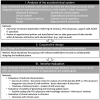Reporting Outcomes of Pediatric Intensive Care Unit Patients to Referring Physicians via an Electronic Health Record-Based Feedback System
- PMID: 35545126
- PMCID: PMC9095343
- DOI: 10.1055/s-0042-1748147
Reporting Outcomes of Pediatric Intensive Care Unit Patients to Referring Physicians via an Electronic Health Record-Based Feedback System
Abstract
Background: Many critically ill children are initially evaluated in front-line settings by clinicians with variable pediatric training before they are transferred to a pediatric intensive care unit (PICU). Because clinicians learn from past performance, communicating outcomes of patients back to front-line clinicians who provide pediatric emergency care could be valuable; however, referring clinicians do not consistently receive this important feedback.
Objectives: Our aim was to determine the feasibility, usability, and clinical relevance of a semiautomated electronic health record (EHR)-supported system developed at a single institution to deliver timely and relevant PICU patient outcome feedback to referring emergency department (ED) physicians.
Methods: Guided by the Health Information Technology Safety Framework, we iteratively designed, implemented, and evaluated a semiautomated electronic feedback system leveraging the EHR in one institution. After conducting interviews and focus groups with stakeholders to understand the PICU-ED health care work system, we designed the EHR-supported feedback system by translating stakeholder, organizational, and usability objectives into feedback process and report requirements. Over 6 months, we completed three cycles of implementation and evaluation, wherein we analyzed EHR access logs, reviewed feedback reports sent, performed usability testing, and conducted physician interviews to determine the system's feasibility, usability, and clinical relevance.
Results: The EHR-supported feedback process is feasible with timely delivery and receipt of feedback reports. Usability testing revealed excellent Systems Usability Scale scores. According to physicians, the process was well-integrated into their clinical workflows and conferred minimal additional workload. Physicians also indicated that delivering and receiving consistent feedback was relevant to their clinical practice.
Conclusion: An EHR-supported system to deliver timely and relevant PICU patient outcome feedback to referring ED physicians was feasible, usable, and important to physicians. Future work is needed to evaluate impact on clinical practice and patient outcomes and to investigate applicability to other clinical settings involved in similar care transitions.
Thieme. All rights reserved.
Conflict of interest statement
None declared.
Figures



References
-
- Duffy F D, Holmboe E S. Self-assessment in lifelong learning and improving performance in practice: physician know thyself. JAMA. 2006;296(09):1137–1139. - PubMed
-
- Berner E S, Graber M L.Overconfidence as a cause of diagnostic error in medicine Am J Med 2008121(5, suppl):S2–S23. - PubMed
-
- Meyer A ND, Singh H. The path to diagnostic excellence includes feedback to calibrate how clinicians think. JAMA. 2019;321(08):737–738. - PubMed
-
- Croskerry P. The feedback sanction. Acad Emerg Med. 2000;7(11):1232–1238. - PubMed
-
- Schiff G D.Minimizing diagnostic error: the importance of follow-up and feedback Am J Med 2008121(5, suppl):S38–S42. - PubMed
Publication types
MeSH terms
Grants and funding
LinkOut - more resources
Full Text Sources
Medical
Miscellaneous

